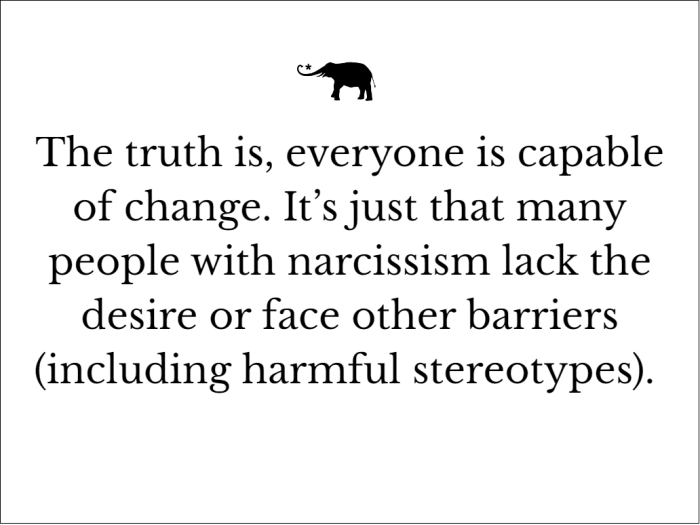Narcissism is characterized by a sense of self-importance, a need for admiration, and a lack of empathy. Due to this, often the question: Can narcissists ever change?
If you, too, have been thinking the same or know of a narcissist who wants to change, this post is here to help. In this article, we attempt to explore narcissism in-depth, the possibility of transformation, and practical steps to bring about change.
Understanding Narcissism
Narcissism goes beyond being a personality trait. It is a concept that encompasses various behaviors and often has its roots in childhood experiences that involve factors like indulgence or neglect. These experiences can contribute to developing tendencies to cope with challenges.
Additionally, narcissistic behaviors can emerge as defense mechanisms against perceived threats to one’s self-esteem. Understanding these defense mechanisms is crucial for comprehending the underlying dynamics of narcissism.
Characteristics of Narcissism:1. Grandiosity and Self-importance
At the core of narcissism lies a sense of self-importance. Individuals with these traits may exaggerate their accomplishments, seek admiration from others, and believe they are unique or superior.
2. Lack of Empathy
Empathy, which involves understanding and sharing the feelings of others, is often lacking in individuals exhibiting traits. This can lead to difficulties in forming connections and empathizing with others’ perspectives.
3. Constant Need for Validation
People with narcissistic tendencies often seek validation from others to maintain their self-esteem. This constant craving for affirmation can be observed through attention-seeking behaviors and a reliance on the admiration of others.
4. Impact on Relationships
Narcissistic traits can present challenges in establishing and sustaining relationships. The excessive focus on self-importance may result in difficulties when it comes to considering the needs and emotions of others.
5. Power Dynamics
Power dynamics frequently play a role in relationships involving individuals with tendencies. Their desire for control and dominance often leads to imbalances in conversations and decision-making processes.
Desire for Change; “I Am a Narcissist and I Want to Change”
Recognizing one’s tendencies and expressing a genuine desire for personal growth is an important first step that requires courage. Here are some practical tips that a person who identifies as a narcissist can take if they truly want to change their behavior.
1. Acknowledging Tendencies
Start by acknowledging and accepting the presence of tendencies within yourself. This self-awareness lays the groundwork for transformation.
2. Exploring Root Causes
Engage in introspection to uncover the causes behind your narcissistic behaviors. Understanding these origins will provide insights into the triggers contributing to these tendencies.
3. Clarify Personal Goals
Take the time to define your goals for change. Whether you want to improve relationships, foster personal growth, or enhance your well-being, having objectives will give you a sense of direction.
4. Stay Motivated
Nurture your motivation by connecting with the reasons behind your desire for change. This inner drive will serve as a force throughout your transformation journey.
5. Seek Therapy and Counseling
Consider seeking therapy or counseling from a health professional. Engaging in interventions like cognitive behavioral therapy (CBT) or psychodynamic therapy can provide support in exploring and addressing any narcissistic traits you may have.
6. Open Communication
Establish honest communication with your therapist. Share your desire for growth. Inquire about therapeutic approaches specifically designed to address narcissistic tendencies.
7. Develop Empathy Skills
Focus on developing and enhancing your skills. Actively listen to others, try to understand their perspectives, and acknowledge their emotions.
8. Practice Perspective Taking
Engage in exercises that promote perspective-taking. Put yourself in someone’s Shoes, imagining their feelings and experiences, which can help you better understand them.
9. Identify Recurring Behaviors
Pay attention to patterns of behavior that keep recurring in your life. Recognize actions or reactions that contribute to difficulties in your relationships.
10. Overcoming Negative Patterns
Make an effort to challenge and disrupt behavioral patterns. This might involve adopting responses and coping mechanisms in situations where narcissistic tendencies typically arise.
11. Taking Personal Responsibility
Accept accountability for one’s actions. Recognize how selfish behaviors impact both oneself and others and be willing to make amends when necessary.
12. Learning from Setbacks
Understand that setbacks are a part of the process of change. Of seeing them as failures, view them as opportunities for learning and personal growth.
13. Being Patient with the Journey
Recognize that transformation takes time and that changing oneself is a process. Practice patience with oneself during the journey of growth.
14. Persisting in the Quest for Change
Stay committed to the pursuit of change with unwavering determination. Consistency and persistence play roles in achieving lasting transformation.
How Can Individuals with Narcissistic Change?
For those facing the complexities associated with narcissism who genuinely desire to change, implementing steps and strategies is crucial. Here, we explore ways individuals can embark on their journey.
1. Self-Reflection
Embrace the longing for change. This self-awareness forms the foundation of the transformative process. Engage in self-reflection to identify any tendencies within yourself. This ongoing process will help you become more aware of your thoughts and actions and how they affect your relationships.
2. Take Help from a Professional
Consider seeking therapy from a mental health professional to address behaviors. Therapeutic approaches, like cognitive behavioral therapy (CBT) or psychodynamic therapy, can provide strategies for addressing these tendencies.
Openly communicate with your therapist, sharing areas of concern and your desire for change. Together, collaborate on a customized plan.
3. Learn to Be Empathetic
Cultivate empathy by listening during conversations. Focus on understanding others’ perspectives without injecting your viewpoints.
Engage in activities that promote empathy, such as reading literature from perspectives or participating in group activities that foster understanding of others’ emotions.
4. Pay Attention to Your Thoughts
Break patterns by recognizing situations that trigger behaviors. Take note of recurring reactions. Explore alternative, constructive responses. Take steps to implement changes aligned with the goal of positive transformation.
5. Take Responsibility for Your Actions
Hold yourself accountable for the impact of your behaviors on others. Acknowledge the toll it may have caused and be willing to make amends when necessary. View mistakes as learning opportunities for growth. By learning from setbacks and applying insights gained, you contribute to accountability.
6. Building Strong Relationships
Make it a priority to value and respect each other in relationships. Remember that healthy connections involve making decisions and considering each other’s feelings.
Strive for connections by encouraging authenticity. Be open to being vulnerable and promote sincerity in relationships.
7. Consistency and Patience
Remember that transformation is a process that takes time. Keep applying the strategies and steps towards change, knowing that progress happens gradually. Be patient with yourself throughout the growth journey, celebrating victories along the way and maintaining a positive mindset despite challenges.
Embracing Change and Personal Growth;
To conclude, the path to change for someone dealing with narcissism requires actions and practical steps. This transformative journey involves self-reflection, therapy, developing empathy, recognizing patterns, taking responsibility for oneself, and committing to relationships.
The true power lies in implementing these strategies, fostering lasting change, and rediscovering a sense of self-aligned with genuine connections. Approaching this journey with intentionality and purpose promises transformation.
For those who acknowledge their tendencies and aspire to change, it is important to recognize that personal growth is an adventure. By combining introspection, professional guidance, empathy development, recognizing patterns, taking responsibility, and perseverance, individuals can embark on a path toward building healthier relationships.
With consistent efforts, the longing for change becomes a catalyst for reshaping the story of life and fostering lasting transformation.


 Share on bsky
Share on bsky





Read 0 comments and reply